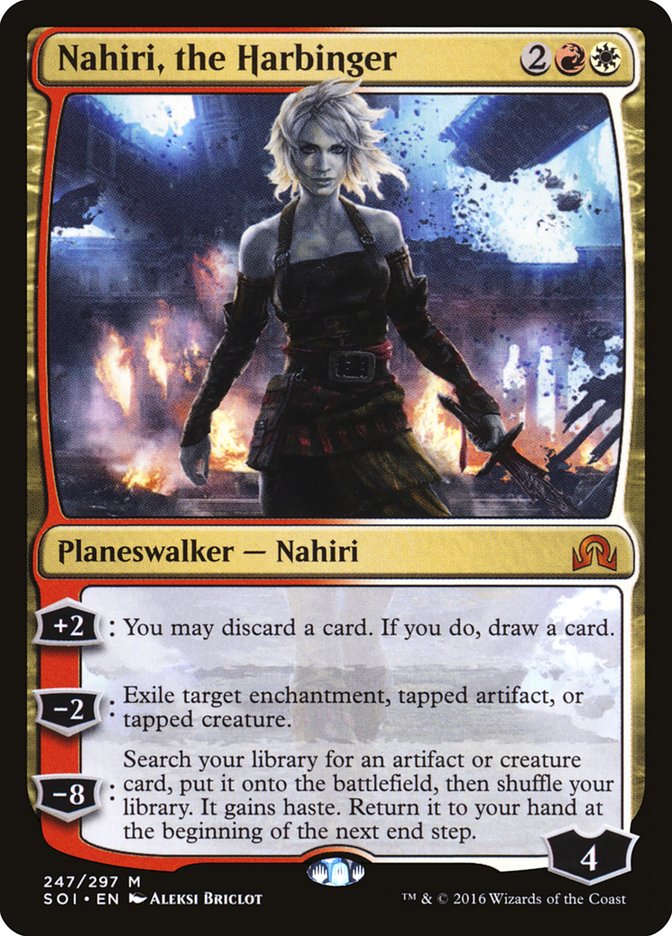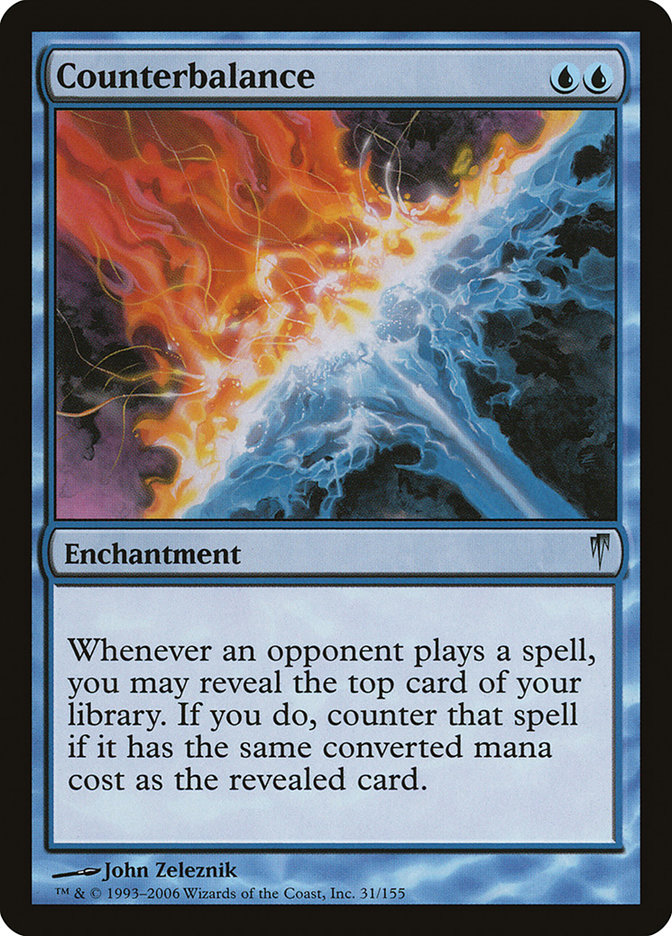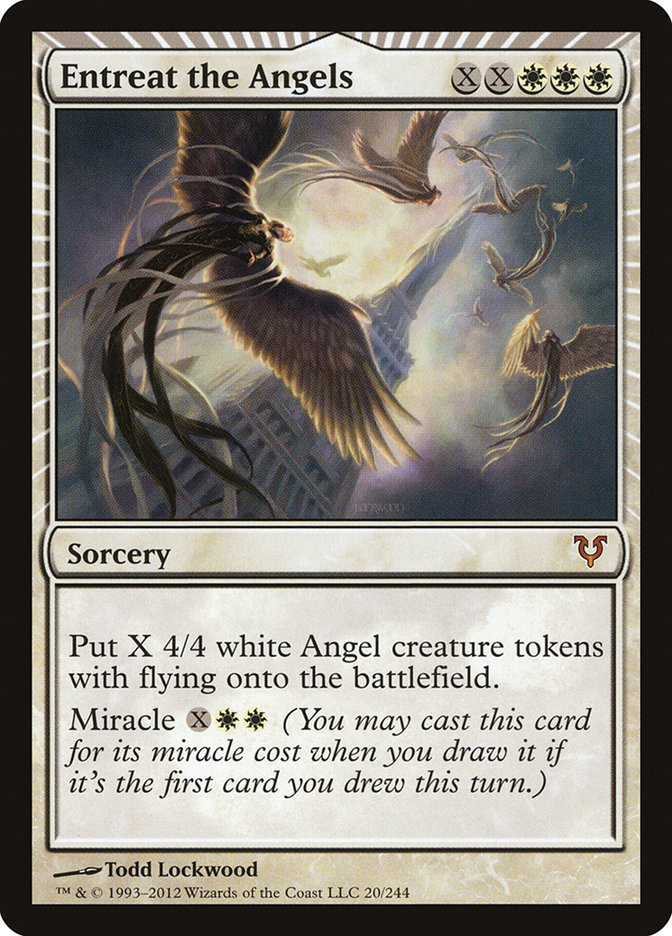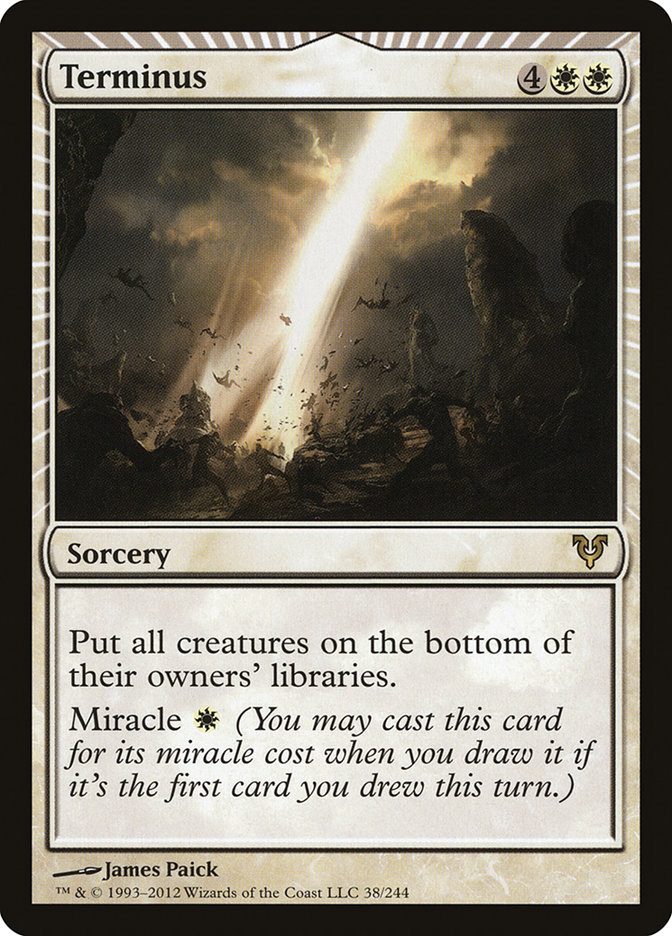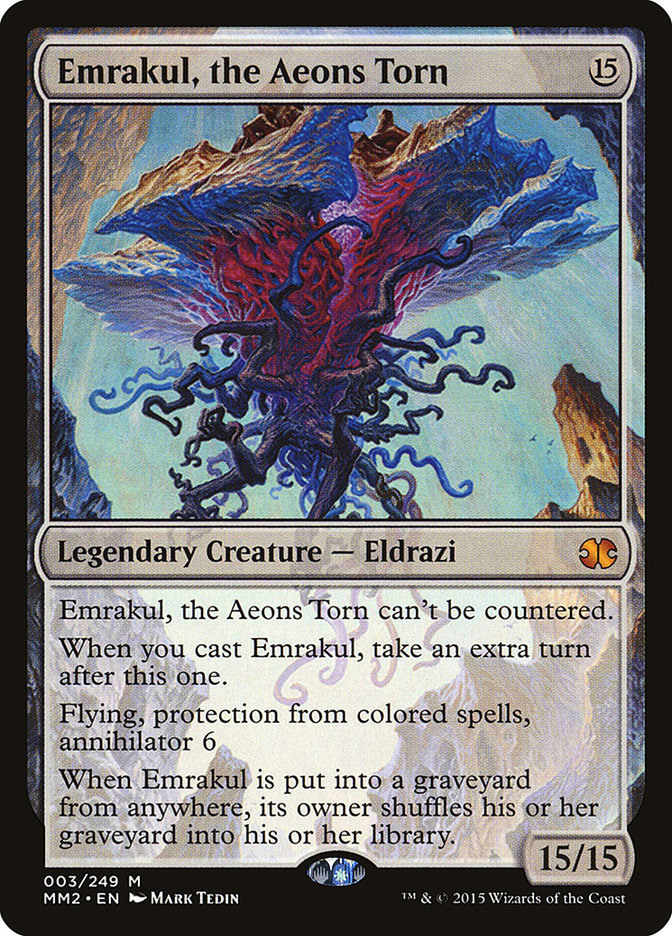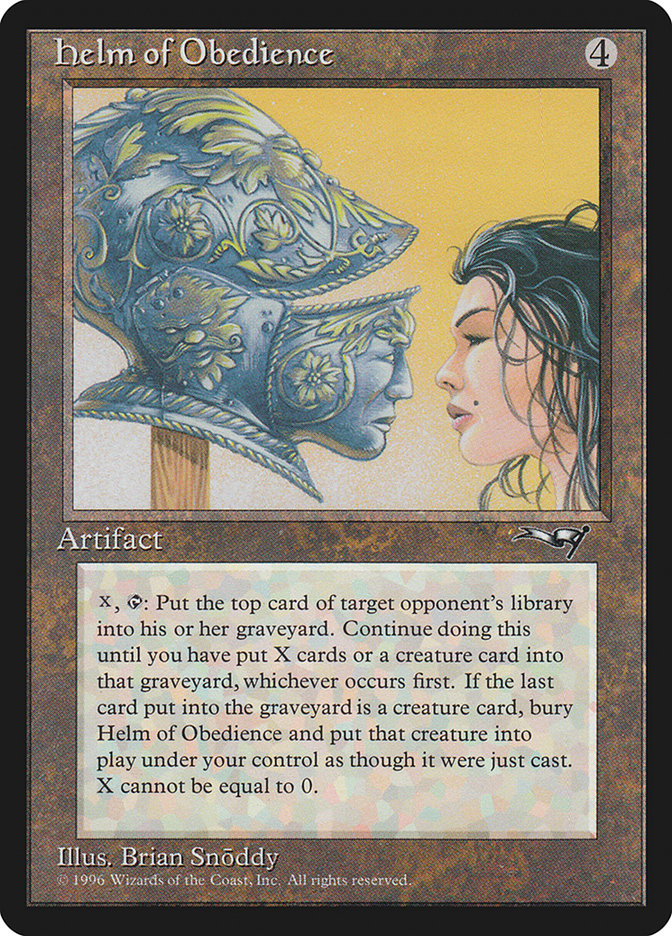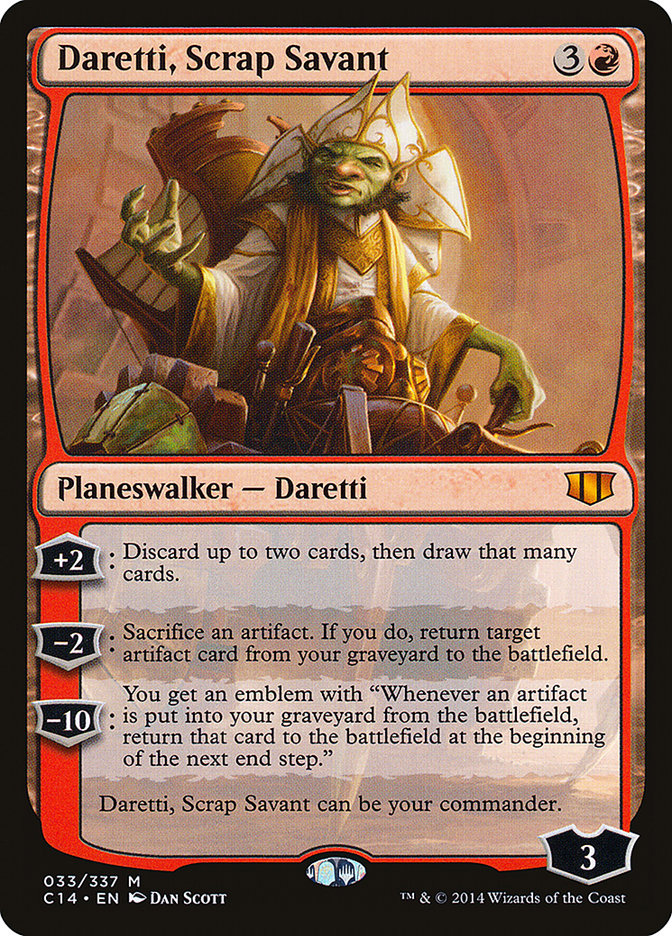 Nahiri, the Harbinger in Legacy.
Nahiri, the Harbinger in Legacy.
Frankly, I haven’t stopped thinking about it since.
This is basically how I work, and it shouldn’t really come as a surprise if you’ve been reading my content (or even just my article last week) that I have the tendency to get fixated on specific decks and cards. Nahiri continues to prove to be the real deal, and I don’t see how being a four-mana planeswalker is going to hold her back from making an impact on Legacy too.
I won’t be spending too much time reiterating why Nahiri is powerful enough to be registered in Legacy at the macro level, but I do want to touch on some key points:
Her +2 ability as deck manipulation is more powerful due to the format. Any kind of additional velocity scales appropriately relative to the strength of the cards it gives a player. The only slight against Nahiri here is that it she is directly competing with Jace, the Mind Sculptor as a four-mana planeswalker. We’ll get back to this.
Her activation to exile enchantments and creatures is extremely powerful. The ability for decks to handle Counterbalances and Blood Moons is exciting. Even more so in Modern, the sizes of Legacy battlefields are often incredibly compact and the value of a “removal spell” that stays on the battlefield and can further an advantage is absolutely massive. Jace, the Mind Sculptor can only temporarily grant reprieve from pressure!
Due to the fact that “Nahiri vs. Jace” is the likely largest point of contention, I think it’s best to start with the deck that will probably use Nahiri the best and that is also blue, Miracles:
Creatures (4)
Planeswalkers (4)
Lands (21)
Spells (31)
- 4 Sensei's Divining Top
- 4 Brainstorm
- 1 Counterspell
- 4 Force of Will
- 4 Swords to Plowshares
- 4 Counterbalance
- 4 Ponder
- 2 Spell Pierce
- 4 Terminus
Sideboard

On the surface there aren’t too many crazy changes to the Miracles shell. I like the use of a full set of Ponders and Snapcaster Mages with a low land count. I’m certainly no Miracles expert, but I’m interested in a list that is hyper-redundant and plays to the deck’s strengths.
The big changes here are the removal of Entreat the Angels or another win condition like maindeck Monastery Mentors and the shaving of Jace, the Mind Sculptors for Nahiri and an Emrakul, the Aeons Torn.
So let’s talk about how Nahiri is going to win us the game. In my experience, Miracles is going to play many long, drawn-out games while “hellbent” and furiously spinning Sensei’s Divining Top to keep the game locked or at parity with Counterbalance, slowly working toward pulling ahead and finally finding and sticking an Entreat the Angels that will win the game.
Matches often take a long time and Entreat is critical as a tool for closing games out before time is called and occasionally stabilizing the battlefield.
Jace, the Mind Sculptor is an excellent tool for pulling ahead on advantage or keeping an opponent off-beat with repeated Unsummons, but largely its ability to be a win condition is minimal as a game is typically locked up long before fateseals end the game. Further, Jace is oftentimes fragile – moving up to five loyalty makes no impact on the battlefield and any attempts to repeatedly bounce creatures will inevitability end in a dead Jace.
Nahiri, on the other hand, puts a massive amount of pressure on an opponent to kill her or you while serving as a permanent answer to a threat the turn that it enters the battlefield. While the Harbinger’s ability to sift through raw cards is significantly weaker, it is attached to a +2 ability instead of a 0. Additionally, while I don’t want to understate the power of Jace’s Brainstorm, it is critical to note that when Sensei’s Divining Top is being activated, both planeswalkers are only working towards looking at one fresh card.
Perhaps the biggest nod against Nahiri is that none of her abilities can stack the top of your deck with a Terminus like Jace can, but when Nahiri is killing your opponent in just a handful of turns, any effort to set up a Terminus to protect her is greatly rewarded.
I do think that playing several four-drops that can’t be exiled to Force of Will is something worth talking about, but when Nahiri is functionally replacing Entreat the Angels as a win condition, there is still a comparable frequency of blue cards in the deck to stock Miracles. That being said, there are also some benefits to not being blue – notably the high number of Pyroblast effects that litter the format.
There are some small issues with the Emrakul kill. Generally speaking there will be no problems in the majority of matchups, but it is possible to run into a Karakas that will ruin our day and force us to go down the path of locking our opponent out and cleaning up with Snapcaster Mage attacks, simply decking our opponent, or moving towards the singleton Jace, the Mind Sculptor. I suspect that this is mostly just an outlier that can be ignored, but I certainly could be wrong.
Perhaps my favorite part of the entire deck list is the potential to move away from the Emrakul kill after sideboarding. Everyone knows how powerful Rest in Peace is as a sideboard option, and there have even been Miracles decks in the past that maindeck the Rest in Peace / Helm of Obedience combo. Here we simply have the option of making the simple switch of Helm of Obedience for our Emrakul, and if Rest in Peace is on the battlefield, then Nahiri fetching Helm is an instant kill. Most folks forget that Nahiri has the ability to tutor up an artifact!
One potentially sweet piece of technology that came up in discussion was Fire // Ice. While the vast majority of artifacts are safe from Nahiri’s clutches, the split card could make gunning down almost any permanent a reality.
Overall I like the look of this list quite a bit and wouldn’t be surprised if I registered something similar for the Grand Prix in a few weeks. Many of my concerns with Miracles stemmed from time limits and my general dislike for cards like Entreat the Angels, which feels like a strict win condition. Nahiri would appear on the surface to alleviate some of those issues by giving Miracles an actively effective manner to put pressure on an opponent that isn’t Counterbalance.
We talked about a few other decks too.
Admittedly, I don’t think it’s possible to provide a deck where Nahiri will slot as fluidly into the overall strategy as Miracles, but I think we can come up with a few viable candidates.
Creatures (16)
- 2 Goblin Welder
- 4 Imperial Recruiter
- 1 Jaya Ballard, Task Mage
- 2 Simian Spirit Guide
- 1 Magus of the Moon
- 4 Painter's Servant
- 1 Phyrexian Revoker
- 1 Spellskite
Planeswalkers (1)
Lands (19)
Spells (24)

Painter has always had issues with dealing with cards like Counterbalance and meaningful pressure. Despite the fact that Nahiri is competing with Daretti, Scrap Savant directly, I think the two are comparable enough that, despite Nahiri being a little bit worse overall in terms of synergizing with the deck, she can make up that ground on versatility.
There’s even no need to slot in a dedicated win condition like Emrakul, rather Nahiri can just tutor up whatever piece is missing from the Grindstone combo and win the game instantly. It wouldn’t even surprise me if Painter could be slanted to be capable of playing longer games. While of course the majority of the power of the deck comes from turbo-powered Blood Moons and various other unfair starts, Nahiri, the Harbinger could certainly give the deck more staying power to compete.
Here’s another deck that our new favorite planeswalker could deserve a spot in:
Lands (35)
Spells (25)
Sideboard

While ultimately we decided that Lands was unlikely to have any main deckslots available for Nahiri (although I’d really like to play a single copy to Gamble for), it could be an incredible sideboard option. William is already willing to sideboard in the full four copies of Krosan Grip, so why not play a Krosan Grip attached to a planeswalker? In particular I like that Nahiri proactively “covers” lands against potent hate like Blood Moon instead of forcing us to repeatedly hold up mana every turn.
It might be easy to assume that something like Sneak and Show, already interested in a bunch of “big monsters,” could easily play Nahiri, but that’s unlikely to improve the quality of the deck. While Sneak and Show is a combo deck, it is also capable of sculpting its hand and playing slower games with a plethora of blue manipulation and countermagic. Further, a third color would put a lot of stress on a deck that already has several colorless lands.
There is, however, a similar deck to Sneak and Show that’s only a single color and is a lot more interested in just trying to brute-force its opponents out.
Creatures (12)
Planeswalkers (4)
Lands (21)
Spells (23)
Sideboard

While jamming a turn 2 Nahiri won’t immediately kill an opponent, it’s certainly likely to accomplish just that in a few short turns. This deck is certainly of the all-in variety, but that doesn’t mean it isn’t powerful!
Our last deck may not actually be functional, but bear with me: perhaps Nahiri’s ability to kill “completely” by herself can be utilized to improve the redundancy of a classic Cedric Phillips favorite.
Creatures (12)
Planeswalkers (4)
Lands (2)
Spells (42)

Granted, white mana looks fairly difficult to get and playing a second land, particularly a non-Mountain, may be blasphemous. That being said, to imagine that the ceiling on Nahiri in Legacy is that she might be able to improve the “turn 1” kill rate of Charbelcher is fairly impressive. Again, while a turn 1 Nahiri might not immediately deal the final blow, I have faith that a turn 3 Goblin Charbelcher can likely get the job done.
Notably, getting Nahiri to resolve on the first or second turn is likely coming from a much lower resource base than a Charbelcher or Empty the Warrens too. It might be possible that Nahiri can simply give the deck more means to fight through resistance.
This is, at least for me, mostly just a fun exercise to see what the Harbinger is capable of doing.
It’s always a blast to take some time to think about Legacy when new sets actually impact the format. Nahiri, the Harbinger isn’t even just a small upgrade on efficiency or a viable sideboard option, but rather a powerful new way to think about designing decks. She has an incredibly exciting array of implications for just about every format in Magic, and I can’t wait to see what folks are able to come up with to play her in a few short weeks.

